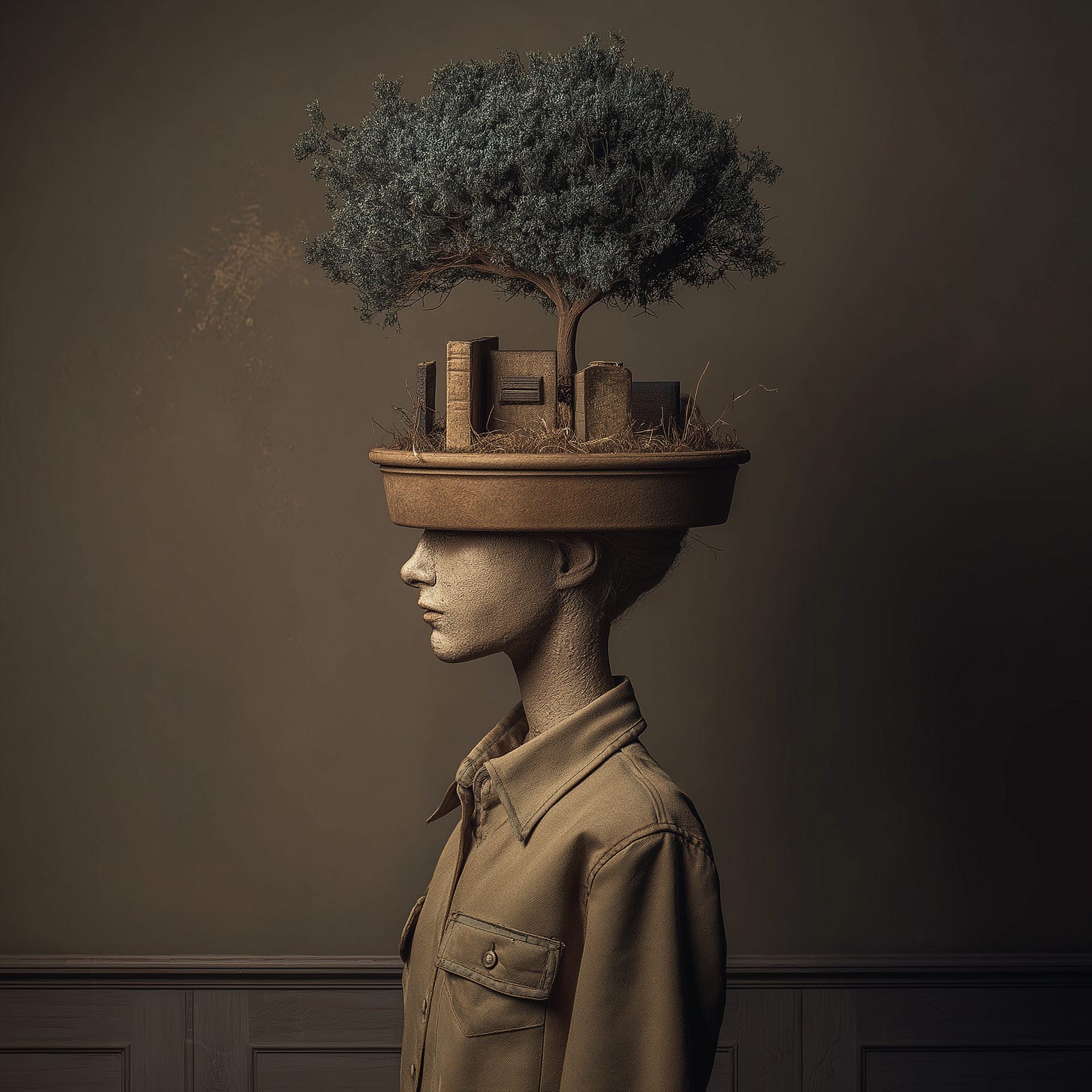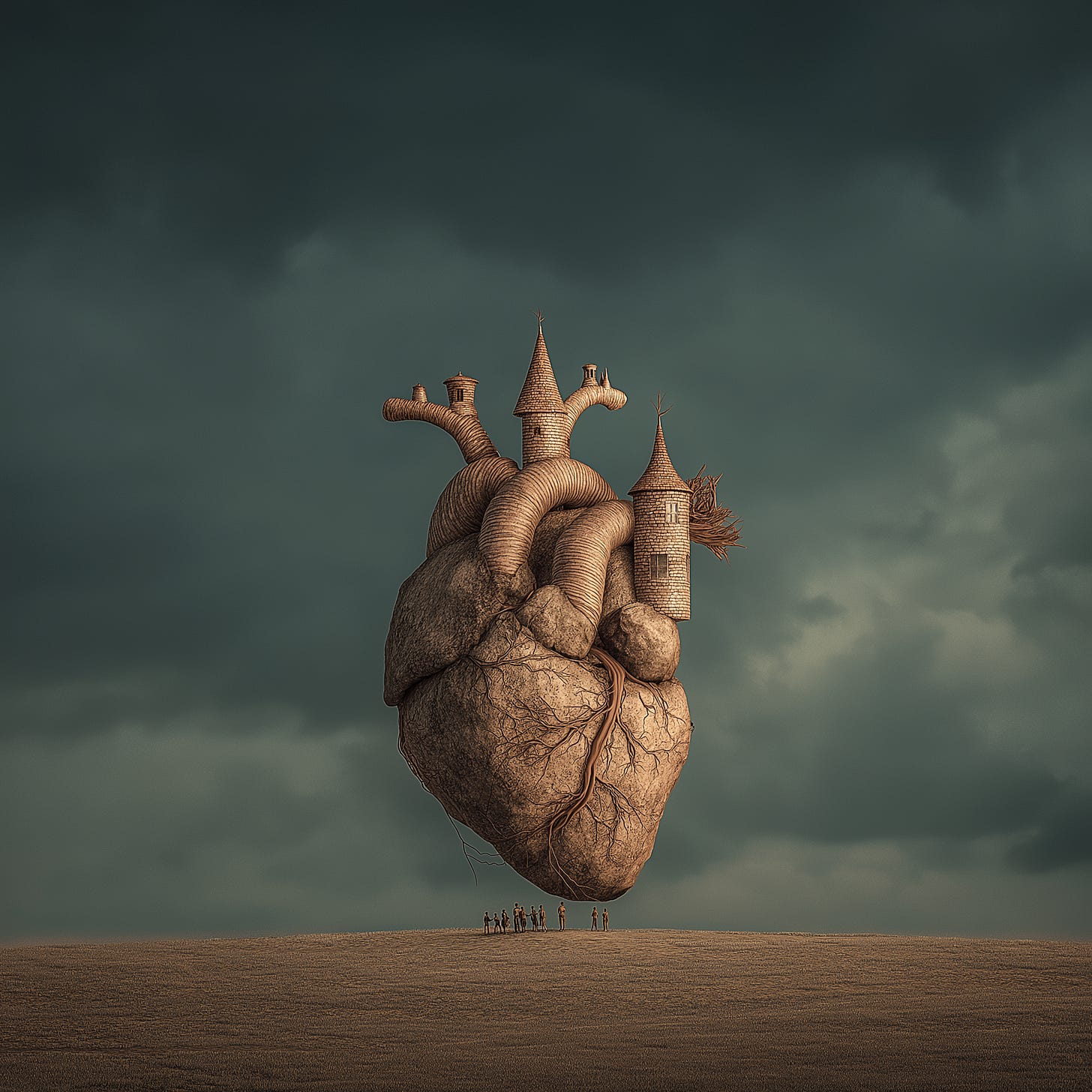The Territory Between
An essay on Ego, Heart, and Shadow
The heart knows things the mind pretends to forget. This morning, sitting at my desk, I caught myself holding my breath again. Email half-read, shoulders inching toward ears, lungs frozen mid-inhale. My body knew I was stressed before my conscious mind was aware of it. This is how it always happens: the breath tells the truth while the ego keeps composing its story.
We misunderstand ego the way we misunderstand soil—seeing only surface, missing the vast network beneath. In therapy rooms and meditation halls, the ego gets cast as the villain, something to transcend, dissolve, or overcome. But notice your breath when you're truly present, truly alive. It doesn't perform aliveness. It simply breathes. The ego isn't the problem. The problem is ego without roots, without connection to the deeper ground of being.
Jung knew this. He spent decades mapping the psyche's underground rivers, tracking how our conscious self—the everyday "I" we wear like a coat—relates to the vast wilderness within. He called it shadow work, but really it's recognition work. Recognition that the parts of ourselves we've exiled don't disappear. They go underground, grow strange in the dark, emerge sideways through our reactions, our sudden rages, our inexplicable tears at commercials about returning home.
The Architecture of Self
A healthy ego moves like water, not stone. It knows its shape but changes with the container. A few weeks ago, at a gathering with a large group, I walked down a hill toward breakfast, matcha in hand, feeling particularly composed. The morning sun caught the steam rising from my cup. Then my foot found the one wet patch of grass. I went down hard, green tea painting my clothes like tie-dye.
For a moment, time split. There was the me covered in matcha, knees muddy, pride bruised. And there was I watching myself, seeing the whole group turn, feeling my ego scramble for dignity like a crab seeking a shell. The healthy response wasn't to pretend it didn't happen or to perform excessive self-deprecation. It was to laugh, genuinely laugh, at the perfect absurdity of the universe's timing.
To allow the ego to bend without breaking.
This is where the heart enters, not as metaphor but as practice. The heart, that fist-sized muscle pumping blood through our days, becomes a bridge between what we think we are and what we actually are. Neuroscience tells us the heart has its own neural network, sends more signals to the brain than it receives from it. The body knows: the heart is not subordinate to the mind but a partner, sometimes a senior partner.
In my twenties, I thought enlightenment meant ego death. I sat on meditation cushions until my hips and knees screamed, trying to think myself out of thinking. But transformation doesn't come through amputation. It comes through integration. The shadow, those rejected parts Jung spent his life illuminating, doesn't want to destroy us. It wants to come home.
The Compassion Practice
Here's what they don't tell you about compassion: it's not soft.
Real compassion has teeth. It says no when no is needed. It holds boundaries like a garden holds its edges—firmly, but with understanding that growth requires both structure and wildness.
I learned this reconciling with a friend after a falling out that left me deeply hurt. Every part of me wanted armor, wanted the satisfaction of rightness, the cold comfort of withheld forgiveness. But compassion asked something harder: not to forget the hurt, not to minimize it, but to hold it alongside love. To see my friend's actions as rising from their own wounds, their own shadow. The conversation wasn't easy. Compassion rarely is. It required me to be precise about my pain while staying open to theirs, to name what broke without breaking them in return.
Modern life treats compassion like a luxury item, something for after we've secured our own oxygen masks. But compassion is the oxygen mask. In a world where isolation masquerades as independence, where we scroll through curated suffering between advertisements, the radical act is to feel, genuinely feel, our interconnection.
In my work as a coach, I've learned the difference between fixing and witnessing. The ego wants to fix; it's how it proves its worth, its usefulness. But my job is to illuminate, not renovate. To shine light on what's possible for someone's growth without forcing them toward it. Sometimes I sit with clients who are describing their stuckness, and I feel my ego lean forward, wanting to hand them solutions like bandages (all while knowing that, at times, bandages are needed). But the heart knows: the witnessing itself is often the medicine. Being seen fully, without judgment or agenda.
Power and Its Shadows
Every system (corporate, political, familial) has its shadow, its unofficial truth living beneath the official story. The executive who speaks of "family values" while working his staff through weekends. The activist whose righteousness becomes its own form of dominance. The parent who loves through control, calling it protection. Power without heart consciousness becomes predation.
We see it in collapsed narcissism masquerading as leadership, in institutions that prioritize their own preservation at the expense of those they claim to serve. But power with integrated ego, aware of its shadow, connected to heart, becomes something else. It becomes service.
Jung said we don't become enlightened by imagining figures of light but by making the darkness conscious. The shadow isn't our evil twin; rather, it's our wholeness, waiting to be revealed. Every quality we admire in others lives somewhere in our shadow.
Every quality we despise, too.
The healthy ego doesn't deny shadow or worship it. It develops relationship with it. Like learning to dance with a partner whose steps you don't yet know, who leads when you expect to follow, who knows rhythms your body has forgotten.
My body keeps its own wisdom about this. Sometimes I catch myself holding my breath—sitting at my desk, reading an email, waiting in line. The held breath knows I'm stressed before my conscious mind does. It's my shadow speaking through my lungs, saying: you're bracing for impact. You're armoring. You're forgetting to be alive.
The breath becomes the teacher. Each time I notice and release, I'm practicing ego flexibility. The ego wants to control, to manage each moment. The breath says: receive, release, receive, release. It's the most basic exchange, yet the most tender form of intimacy—taking in the world, letting it go, and being changed by the process.
The Territory of the Heart
We live in the space between light and shadow, between ego and essence, between self and other. This is the territory of the heart—not a peaceful middle ground but a dynamic edge, alive with tension and possibility.
The heart doesn't transcend ego; it includes it. Doesn't eliminate shadow; it integrates it. The heart knows what the mind struggles to accept: we are multiple, not singular. We contain ocean and mountain, mother and child, the one who flies and the one who falls.
Modern life asks us to choose sides, to brand ourselves, to perform consistency across platforms. But the heart pulses with paradox. It says: be fully yourself, knowing that the self is not fixed but fluid. Develop ego strength not as armor but as architecture—flexible, responsive, able to shelter others without losing its own form.
The work isn't to eliminate ego but to right-size it, to give it proper work like training a guard dog to distinguish between genuine threats and passing squirrels. The ego, properly related to the heart, becomes discernment. It helps us navigate the world's demands without losing our deeper knowing.
That morning with the matcha, covered in green, surrounded by concerned faces, I understood something about grace. Not the ethereal kind, but the earthed kind—the grace of accepting our spectacular ordinary humanity. The grace of letting ego serve rather than rule. The grace of breathing through the held places.
This is the revolution hidden in plain sight: not transcendence but presence, not perfection but wholeness, not light without shadow but light that knows its shadow, dances with it, draws strength from the tension between what's visible and what's hidden, what's said and what's felt, what we know and what we're still discovering.
The breath returns, as it always does, without fanfare or philosophy. In, out. Receive, release. Each cycle a small death, a small birth, a declaration of presence.
Here I am, it says to the morning.
Still here. Still fierce. Still fragile. Still whole.
Emergence with Rachel Weissman is a weekly exploration of the interconnections between consciousness, technology, and planetary flourishing.
If you find this writing valuable, leave a heart ❤️, share it with a friend, and consider subscribing if you haven’t already.




